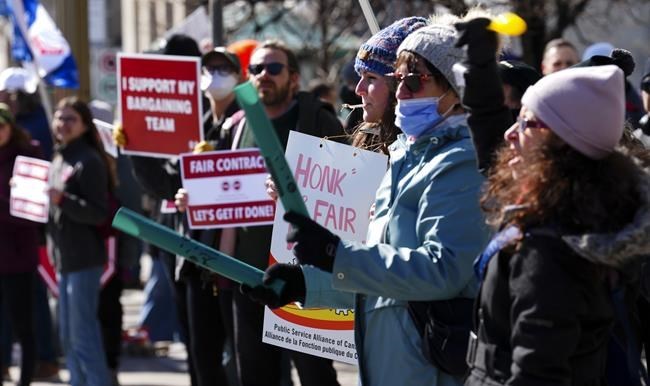OTTAWA — Bogdan Wozniak arrived to open his hotdog stand in downtown Ottawa Tuesday for the first time this season, and was greeted by a vision from the past.
Crowds of public servants walked down the pedestrian street south of Parliament Hill at lunch time, some carrying coffees as they strolled and chatted with colleagues.
"It feels like life going back to normal," said Wozniak as watched the crowd from behind his grill.
He said he hasn't seen the streets of downtown Ottawa so lively since before the pandemic.
But it's still not quite pre-pandemic normal. The workers were only downtown to march in picket lines, set up as a strike of 150,000 federal public servants with the Public Service Alliance of Canada dragged into a seventh day.
One of their key demands is the right to work remotely.
It is one four sticking points Treasury Board President Mona Fortier identified in the contract talks in an open letter she sent out Monday. And if the workers prevail, a downtown that was built around the federal public service, will suffer.
"That's gonna be tough for people who have a business in downtown and rely on them," said Wozniak.
Federal office workers spent most of the pandemic working remotely, leaving many of downtown businesses without their largest source of clients.
On Tuesday though, Little Victories, an independent coffee roaster in a historic building near the National War Memorial, had a lineup that extended to the door as people holding union flags and wearing red support buttons waited to order their morning coffees before hitting the picket lines.
"I've heard that coffee shops are definitely booming," said Michelle Groulx, executive director at the Ottawa Coalition of Business Improvement Areas.
Now that public servants have returned to picket for at least four hours a day in order to receive their strike pay, some businesses are getting a taste of the good old days — even if it's only temporary.
Others haven't had much respite since the pandemic. Many urban centres are experiencing the same dearth of weekday customers since COVID-19 struck, but few relied so heavily on public servants.
"When you have like a population of one specific type, and that happens to be federal servants that are not working in the office as much, you're certainly going to see that whole entire population disappear as customers," Groulx said.
In December, Treasury Board President Mona Fortier ordered federal workers to return to the office at least two days a week in an attempt to create a consistent policy across the public service.
The union argues the pandemic provided proof that workers can be just as effective at home as they can in the office.
Fortier has since offered to review return to office practices as part of an updated contract offer.
Ariel Troster, the Ottawa city councillor whose ward includes downtown Ottawa, said the directive that federal workers return to the office part time hasn't brought activity levels back to what they were before the pandemic. She said on any given day there are still at least 80,000 fewer people downtown than before.
"We're operating based on the assumption that we will not see the same numbers of people returning from nine to five, five days a week," Troster said.
That's forcing the city to rethink the downtown core.
She is on a committee with federal and municipal politicians, as well as housing developers and not-for-profit organizations to reimagine and revitalize the area around Parliament Hill.
That includes taking an inventory of unused federal buildings to see what could be repurposed into affordable or market rate apartments.
It may be difficult to do that before the federal government and the union come to an agreement about how often workers will be using that office space.
"I think the city just wants to know, either way, so that we can plan," Troster said.
On the picket line Tuesday, Aisha Sow, a public servant for 18 years, said commuting into downtown for the last few days feels a bit like déjà vu.
She used to take two buses to get to work every day, but hadn't returned to work until the strike started because of a medical exemption that allows her to work from home full time.
She said she doesn't miss being downtown.
If she could, she would strike from home, but it's not an option.
"I would not come back, seriously," she said.
Troster said the city needs to diversify the downtown to encourage people like Bow to visit in their off-work hours.
"I'm certainly enjoying having more people in the downtown core and maybe encouraging them to come back in their spare time," Troster said.
Until then, it's expected the bustling vision of Ottawa past is likely to disappear again when a deal is finally struck between the union and the federal government.
This report by The Canadian Press was first published April 24, 2023.
Laura Osman, The Canadian Press




